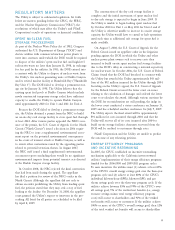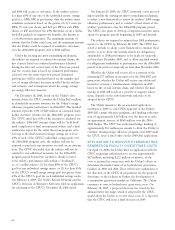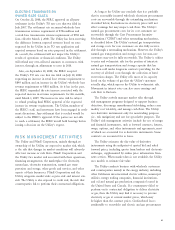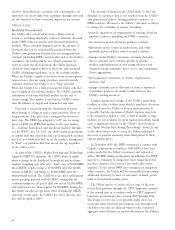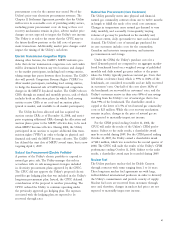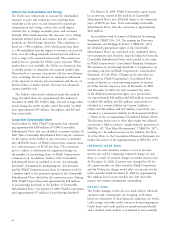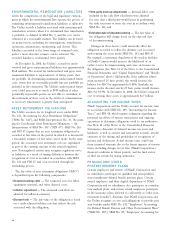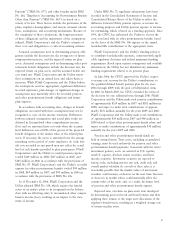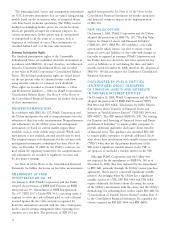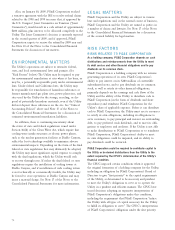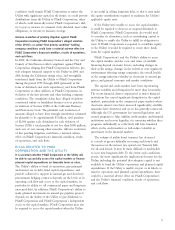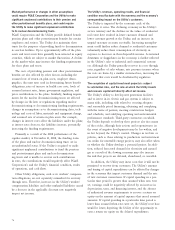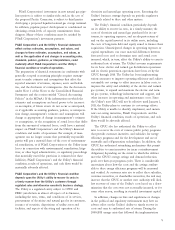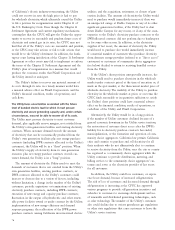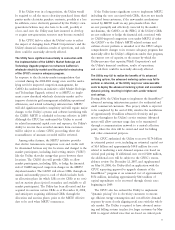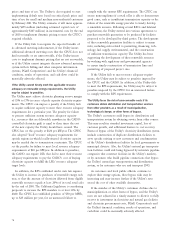PG&E 2008 Annual Report Download - page 70
Download and view the complete annual report
Please find page 70 of the 2008 PG&E annual report below. You can navigate through the pages in the report by either clicking on the pages listed below, or by using the keyword search tool below to find specific information within the annual report.
68
between market participants at the measurement date, or
the “exit price.” The hierarchy gives the highest priority
to unadjusted quoted prices in active markets for identical
assets or liabilities (Level 1 measurements) and the lowest
priority to unobservable inputs (Level 3 measurements). Assets
and liabilities are classifi ed based on the lowest level of
input that is signifi cant to the fair value measurement. (See
Notes 2 and 12 of the Notes to the Consolidated Financial
Statements for further discussion on SFAS No. 157.)
Level 3 Instruments at Fair Value
As Level 3 measurements are based on unobservable inputs,
signifi cant judgment may be used in the valuation of these
instruments. Accordingly, the following table sets forth the
fair values of instruments classifi ed as Level 3 within the fair
value hierarchy, along with a description of the valuation
technique for each type of instrument:
Value as of
December 31, January 1,
(in millions) 2008 2008
Money market investments
(held by PG&E Corporation) $ 12 $ —
Nuclear decommissioning trusts 5 8
Price risk management instruments (156) 115
Long-term disability trust 78 87
Dividend participation rights (42) (68)
Other (2) (4)
Total Level 3 Instruments $(105) $138
Level 3 fair value measurements represent approximately
5% of the total net value of all fair value measurements
of PG&E Corporation. During the twelve months ended
December 31, 2008, there were no material increases or
decreases in Level 3 assets or liabilities resulting from a
transfer of assets or liabilities from, or into, Level 1 or
Level 2. The majority of these instruments are accounted
for in accordance with SFAS No. 71, as amended, as they
are expected to be recovered or refunded through regulated
rates. Therefore, changes in the aggregate fair value of these
assets and liabilities (including realized and unrealized
gains and losses) are recorded within regulatory accounts
in the accompanying Consolidated Balance Sheets with the
exception of the dividend participation rights associated
with PG&E Corporation’s Convertible Subordinated Notes.
The changes in the fair value of the dividend participation
rights are refl ected in Other income (expense), net in PG&E
Corporation’s Consolidated Statements of Income. Changes
in the fair value of the Level 3 instruments did not have
a material effect on liquidity and capital resources as of
December 31, 2008.
Fixed income returns were projected based on real matu-
rity and credit spreads added to a long-term infl ation rate.
Equity returns were estimated based on estimates of dividend
yield and real earnings growth added to a long-term rate of
infl ation. For the Utility’s defi ned benefi t pension plan, the
assumed return of 7.3% compares to a ten-year actual return
of 4.6%.
The rate used to discount pension and other post-
retirement benefi t plan liabilities was based on a yield curve
developed from market data of approximately 300 Aa-grade
non-callable bonds at December 31, 2008. This yield curve
has discount rates that vary based on the duration of the
obligations. The estimated future cash fl ows for the pension
and other postretirement obligations were matched to the
corresponding rates on the yield curve to derive a weighted
average discount rate.
The following refl ects the sensitivity of pension costs and
projected benefi t obligation to changes in certain actuarial
assumptions:
Increase in
Projected
Increase Benefi t
Increase in 2008 Obligation at
(decrease) in Pension December 31,
(in millions) Assumption Costs 2008
Discount rate (0.5)% $15 $667
Rate of return on
plan assets (0.5)% 47 —
Rate of increase in
compensation 0.5% 17 162
The following refl ects the sensitivity of other post-
retirement benefi t costs and accumulated benefi t obligation
to changes in certain actuarial assumptions:
Increase Increase in
in 2008 Accumulated
Other Benefi t
Increase Post- Obligation at
(decrease) in retirement December 31,
(in millions) Assumption Benefi t Costs 2008
Health care cost trend rate 0.5% $6 $33
Discount rate (0.5)% 6 75
NEW ACCOUNTING POLICIES
FAIR VALUE MEASUREMENTS
On January 1, 2008, PG&E Corporation and the Utility
adopted the provisions of SFAS No. 157. SFAS No. 157
establishes a fair value hierarchy that prioritizes inputs to
valuation techniques used to measure the fair value of an
asset or liability. The objective of a fair value measurement
is to determine the price that would be received to sell an
asset or paid to transfer a liability in an orderly transaction



